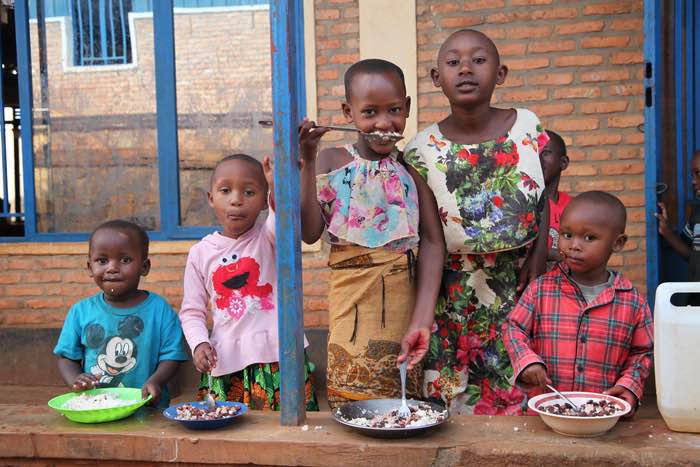
Example of a kitchen garden in the Mahama refugee camp. Credit: WFP/Aristide GATERA
As the sun casts its morning light over Mahama camp, the largest refuge for many who fled violence in Burundi in 2015 and conflict-ridden eastern regions of the Democratic Republic of the Congo (DRC), it illuminates the resilience of individuals like Florida Buzima (pseudonym used for protection). With a smile, Florida sits on a small wooden chair, preparing breakfast for her family. In her cooking pan simmers a blend of maize grains, beans provided by the United Nations World Food Programme (WFP), and fresh green vegetables from her kitchen garden. Nearby, one of her youngest children eagerly anticipates the upcoming meal. Since 2022, she has called this camp her second home, after leaving her native village in the Masisi region of eastern DRC to escape the bullets and turmoil that have plagued this area for decades. Large parts of North Kivu have been damaged by relentless insecurity and clashes among various armed factions and government forces.
Florida’s journey to Rwanda led her through the Nkamira transit centre. Welcomed by the Government of Rwanda, she and her children received life-saving food and nutritional support from WFP. Even after their transfer to Mahama camp, this lifeline persisted.
When encountered in the middle of Mahama, the largest among five refugee camps in Rwanda, and asked about the prospect of returning home, Florida’s miserable nod and words speak volumes: “I have no hope because fighting is still going on in my village and the entire North Kivu province.” Her daily prayers echo a simple plea—for food to feed her four children and the promise of refugee status until peace finds its way back to her homeland.

Children enjoying a hot lunch provided to asylum seekers at the Mahama refugee camp. Credit: WFP/John Paul SESONGA
Currently, Rwanda hosts nearly 135,000 refugees and asylum seekers, primarily from the DRC and Burundi. In camps and transit centres, they depend mainly on humanitarian food assistance, made possible by financial contributions from partners such as the European Commission’s Department for Civil Protection and Humanitarian Aid Operations (DG ECHO). WFP’s efforts translate into tangible support—in 2022, over US$8 million directly reached local markets through food and nutrition assistance to refugees using the cash transfers modality. This cash assistance not only grants families in refugee camps the choice in determining how to address their essential food needs, but it also benefits host communities as refugees buy food from markets in and around camps, including from local smallholder farmers.
In the face of ongoing conflicts and displacement in the region, the story of Florida and the life-saving food assistance she receives while living in the camp with limited livelihood opportunities is one of resilience, and the transformative power of sustained humanitarian support WFP is receiving from partners like DG ECHO. Inka HIMANEN, WFP’s acting Representative and Country Director, says: “WFP is grateful for the European Union’s consistent funding, which has helped maintain food assistance to both asylum seekers and refugees in the Mahama refugee camp.”
WFP, in collaboration with the government through the Ministry in charge of Emergency Management (MINEMA), and other UN agencies, strive to integrate refugees into local communities, fostering self-reliance through income-generating activities and social cohesion.
Despite the generous support from funding partners towards WFP to continue providing monthly food assistance to vulnerable refugees, they now only receive 63 percent of their cash entitlements due to insufficient funding. WFP needs EUR 20.4 million to sustain life-saving assistance for camp-based refugees and asylum seekers throughout 2024. The lack of additional financial support to meet the basic needs of refugees and asylum seekers will have dire consequences for these vulnerable people as they may opt for negative coping mechanisms such as reducing the number of nutritious quality meals. Their relationship with host communities might also be affected as refugees and asylum seekers may leave the camp and resort to desperate measures such as stealing food from neighbouring villages which poses a risk to social cohesion.
With complementary funding, WFP envisages providing additional nutritious food to the most vulnerable members of the refugee population including children aged 6 – 3 23 months, pregnant and breastfeeding women and girls, children aged 6 – 59 months (about 5 years) and people with HIV/AIDS on antiretroviral treatment or Tuberculosis. Refugee and host community children attending the same schools also receive support to access school meals. With sufficient funds, WFP can maintain its social and behaviour change communication for nutrition in the camps, strengthening initiatives such as kitchen gardens, mother-to-mother support groups to encourage peer adaptation of good feeding practices, and promoting self-reliance through savings groups and livelihoods through small livestock rearing. All these initiatives contribute to building the resilience of some of the most vulnerable people in Rwanda – people like Florida. (End)
